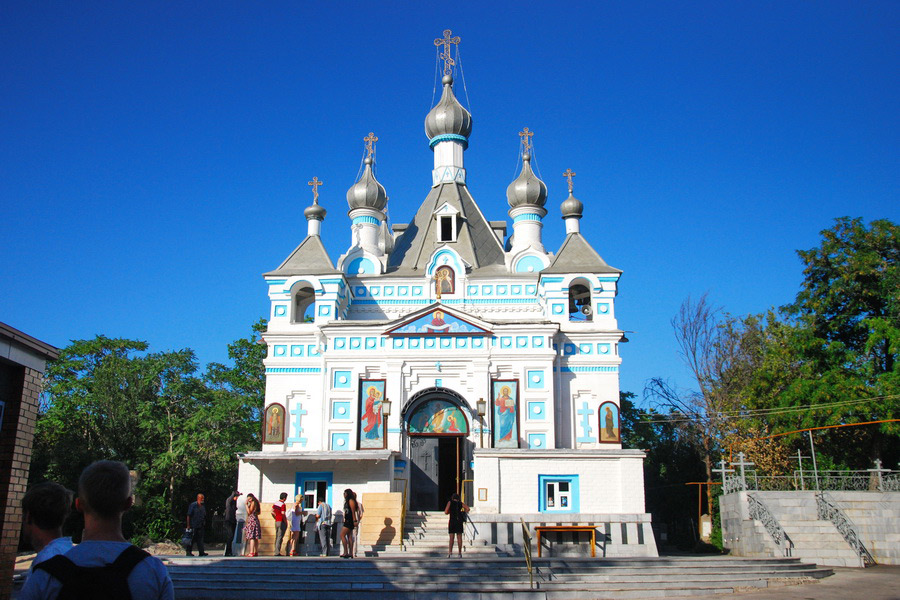Cathedral of Aleksandr Nevsky, Tashkent

The foundation of a new church was laid in the name of Saint Blessed Prince Aleksandr Nevsky on a small hill inside the Orthodox town cemetery, nowadays called Botkinskoe, in Tashkent on November 23, 1902. The first stone of the cathedral construction was consecrated on December 6, 1902. The cathedral was built in 1903-1904 as per the order given by a former District Engineering Command. Initial money for the cathedral construction was given by the Chief of Engineers general Vernander. Construction of the church was completely finished in 1905.
The main contribution was made by Nikolay Ivanovich Ivanov, an adviser on commercial issues, which financial resources were used while construction of iconostasis. Despite the iconostasis was made of wood, it was beautiful, elegantly made and gilded.
Design of the church belongs to Engineer Burmeyster L., work process - to military Capitan Smirnov Ph.V.
The architectural solution makes this cathedral be the finest sample of church architecture.
The cathedral inside was pargeted with ganch and painted in turquoise; the ceilings were white-colored. Floors were covered with cement plates; wood floor of the sanctuary was colored by oily and grey paint. Step was wood and grey-colored.
The choirs of singers were made above the entrance at the western walls of the church.
There are two bell towers built on two sides in front of the cathedral.
Three bells with 0,25 tons of total weight were cast for the church. The biggest one has 12 pounds. It is known that the bells were cast by an artisan Polishenko in Tashkent.
A throne of the church was consecrated by the decent archpriest Konstantin Bogorodicky in the name of Saint Blessed Prince Aleksandr Nevsky on May 8, 1905. Saint antimension was celebrated by His Emi-nance Paisy who was a bishop of Tashkent and Turkestan on May 9, 1903; the antimension was issued on June 11, 1903. In the beginning of the 20's 20th century the church was captured by the Renovationists. The orthodox parishioners had to celebrate divine services near the chapel "Joy of all who Sorrow".
The Russian Orthodox Society nearby the town cemetery of Tashkent was registered in 1942 and Saint Blessed Prince Aleksandr Nevsky Cathedral was handed over to this society. In 1944 a group of believers that is the followers of patriarch church advocated for their registration as an independent society and their taking of the church - chapel located on the cemetery. The chapel was handed over to the society under the condition that the parallel services will not be celebrated there and the chapel will be used for its ordinary designation - a requiem service. After public penance and parables the cathedral was re-united with the Orthodox church. The building of the church was heavily damaged due to fire in the 30's of 20th century. New cupolas were erected in the beginning of the 60's.
On May 1996 Sanctifier Tombs were restored for the first time. That was a place of rapture found by Metropolitan Nikandr (February 18, 1933), metropolitan of Tashkent Arseny (February 28, 1936) and metropolitan of Tashkent Gabriel (February 28, 1971). The Cathedral of Saint Blessed Prince Aleksandr Nevsky was restored also. Restoration works took four months. The arches and walls were re-newed, frescos and damaged icons of Ivoer Mother of God, Aleksandr Nevsky and the big Crucifixion were repainted. For walls was chosen a color of sea-green and its taints. Frescos were painted in bright colors. Rosace of a cupola shines with rainbow colors and golden rays.
An image of the Holy Trinity is placed in the center of the fresco: God - Father, God - Son and God - Holy Spirit in appearance of a dove with spread wings. At the sides and lower part of the fresco - host of Angels and Archangels, Saint Johan the Baptist praying for remission of human sins. The fresco is ex-panded all around a wall above the floor. This fresco as well as everything that was subject to restoration was consecrated in autumn 1996.
Graves of dozen of priests, deacons and religious men, that is almost all the ancient priesthood of Tashkent, are located on Botkinskoe cemetery. The number of the most honorable graves includes deposition of archimandrite Boris (Kholchev).

